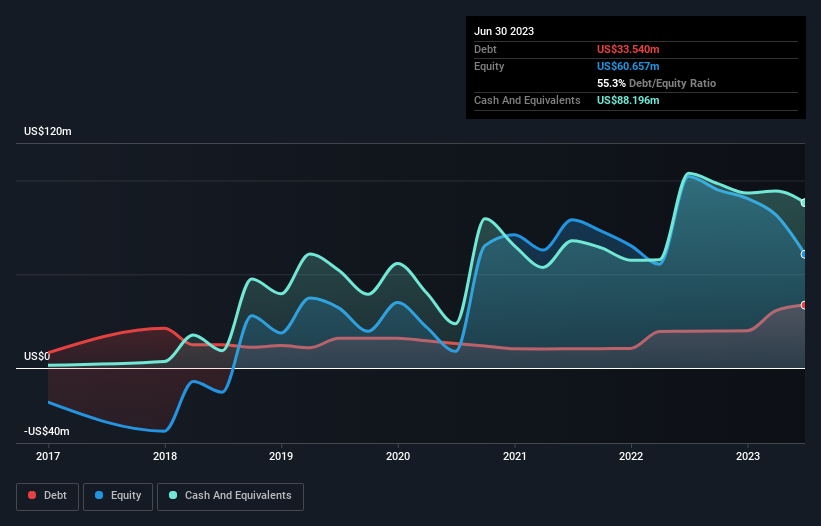David Iben put it well when he said, 'Volatility is not a risk we care about. What we care about is avoiding the permanent loss of capital.' When we think about how risky a company is, we always like to look at its use of debt, since debt overload can lead to ruin. We can see that Liquidia Corporation (NASDAQ:LQDA) does use debt in its business. But is this debt a concern to shareholders?
What Risk Does Debt Bring?
Debt assists a business until the business has trouble paying it off, either with new capital or with free cash flow. If things get really bad, the lenders can take control of the business. While that is not too common, we often do see indebted companies permanently diluting shareholders because lenders force them to raise capital at a distressed price. Of course, the upside of debt is that it often represents cheap capital, especially when it replaces dilution in a company with the ability to reinvest at high rates of return. The first thing to do when considering how much debt a business uses is to look at its cash and debt together.
Check out our latest analysis for Liquidia
How Much Debt Does Liquidia Carry?
As you can see below, at the end of June 2023, Liquidia had US$33.5m of debt, up from US$19.6m a year ago. Click the image for more detail. However, its balance sheet shows it holds US$88.2m in cash, so it actually has US$54.7m net cash.

How Healthy Is Liquidia's Balance Sheet?
We can see from the most recent balance sheet that Liquidia had liabilities of US$19.5m falling due within a year, and liabilities of US$41.4m due beyond that. Offsetting this, it had US$88.2m in cash and US$4.10m in receivables that were due within 12 months. So it actually has US$31.4m more liquid assets than total liabilities.
This short term liquidity is a sign that Liquidia could probably pay off its debt with ease, as its balance sheet is far from stretched. Simply put, the fact that Liquidia has more cash than debt is arguably a good indication that it can manage its debt safely. The balance sheet is clearly the area to focus on when you are analysing debt. But it is future earnings, more than anything, that will determine Liquidia's ability to maintain a healthy balance sheet going forward. So if you want to see what the professionals think, you might find this free report on analyst profit forecasts to be interesting.
In the last year Liquidia wasn't profitable at an EBIT level, but managed to grow its revenue by 29%, to US$18m. With any luck the company will be able to grow its way to profitability.
So How Risky Is Liquidia?
Statistically speaking companies that lose money are riskier than those that make money. And in the last year Liquidia had an earnings before interest and tax (EBIT) loss, truth be told. And over the same period it saw negative free cash outflow of US$26m and booked a US$51m accounting loss. Given it only has net cash of US$54.7m, the company may need to raise more capital if it doesn't reach break-even soon. Liquidia's revenue growth shone bright over the last year, so it may well be in a position to turn a profit in due course. Pre-profit companies are often risky, but they can also offer great rewards. The balance sheet is clearly the area to focus on when you are analysing debt. However, not all investment risk resides within the balance sheet - far from it. For example, we've discovered 1 warning sign for Liquidia that you should be aware of before investing here.
When all is said and done, sometimes its easier to focus on companies that don't even need debt. Readers can access a list of growth stocks with zero net debt 100% free, right now.
New: AI Stock Screener & Alerts
Our new AI Stock Screener scans the market every day to uncover opportunities.
• Dividend Powerhouses (3%+ Yield)
• Undervalued Small Caps with Insider Buying
• High growth Tech and AI Companies
Or build your own from over 50 metrics.
Have feedback on this article? Concerned about the content? Get in touch with us directly. Alternatively, email editorial-team (at) simplywallst.com.
This article by Simply Wall St is general in nature. We provide commentary based on historical data and analyst forecasts only using an unbiased methodology and our articles are not intended to be financial advice. It does not constitute a recommendation to buy or sell any stock, and does not take account of your objectives, or your financial situation. We aim to bring you long-term focused analysis driven by fundamental data. Note that our analysis may not factor in the latest price-sensitive company announcements or qualitative material. Simply Wall St has no position in any stocks mentioned.
About NasdaqCM:LQDA
Liquidia
A biopharmaceutical company, develops, manufactures, and commercializes various products for unmet patient needs in the United States.
High growth potential with mediocre balance sheet.
Market Insights
Community Narratives




